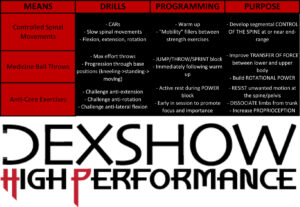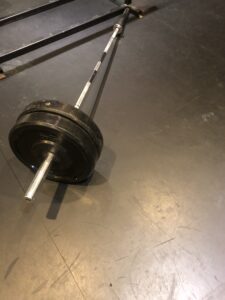I love online, viral fitness challenges – they bring importance to the overwhelmingly positive aspects of exercise, create accountability, and emphasize the community aspect of fitness. I also hate online, viral fitness challenges – people unknowingly perform most exercises poorly, with major compensations, which may end up causing pain and/or more dysfunction. While focusing on being more active on social media, and specifically Instagram, I went down the rabbit hole of watching #10pushupchallenge videos. It didn’t take long for me to start cringing and grimacing, not unlike the challengers themselves as their shoulders began to hurt and their technique deteriorated. It’s my intent here to break down one of the most unassuming, yet most effective, upper body pushing movements – the PUSH UP. I’ll share the prerequisites, some common movement faults or compensations, what to do about them AT HOME WITH NO EQUIPMENT, and how to work up to a full, bodyweight push up and beyond.
Start on your hands and toes, lower yourself until your nose touches the floor and then push back up, easy right? Simple, yes. Easy, no. The humble push up requires:
- Scapular (shoulder blade) control and awareness
- Upper back strength and mobility
- Dynamic anterior core stability
- High relative strength to body weight ratio
- Wrist extension mobility
The Good: All of these qualities are trainable and there are unlimited push up regressions and progressions to help get anybody to that crisp, full body weight push up or the fabled single-arm push up.
The Bad: In my experience, the majority of people lack most – if not all – of the individual prerequisites for a push up, yet try to perform them anyways (often for an inordinate amount of reps).
The Ugly: Doing push ups with poor form can cause pain, reinforce poor motor patterns, and leave you farther away from your health and wellness goals.
Now we can get into the good stuff – how to fix the #10pushupchallenge and set you up for solid push up gains during the quarantine and beyond.
1. The Shoulder Dumper
This is probably the most common issue I see when it comes to push ups (tied with #2). Your shoulders dump forward and hike up towards your ears because you aren’t controlling your scapulae (shoulder blades) well. I’m not a psychic but I can tell you that this will lead to anterior shoulder pain in the future. How do you fix it?
Bring awareness to how your scapulae move in space:
Actively taking your scapulae through a full range of motion alone can help to develop some of the musculature involved in moving your shoulder blades. It can also give some awareness to how limited your scapular range of motion may be. Once feeling the end points of rotational movement, move down to the floor to load some scapular retraction and protraction – essential movements for a solid push up. Do a set of 3 Scapular CARs in each direction, followed by 10 Scapular Push Ups at a slow tempo. Repeat for 2-3 sets.
Strengthen your upper back musculature:
Ears are toxic to shoulders so keep them down and back for the Y|T|Ws, using your upper back to perform the positional holds. Be strict with the Floor Slides and be sure to keep your elbows and wrists glued to the floor. The Batwing Wall Plank should look and feel like the bottom of a push up or the top of a row variation– shoulder blades squeezed, thinking about putting your elbows into your back pockets. Run 3 sets of this circuit, resting as little as needed.
Do twice as much pulling as pushing every week (for every push exercise programmed, there needs to be two pulling exercises):
Overdeveloped chest and anterior deltoids and underdeveloped upper back and posterior shoulders is a recipe for shoulder pain. Over the course of your training week, you need to pull with your upper body twice as often as you push with your upper body, PERIOD. All back exercises will augment your chest exercises, but it doesn’t work the other way around. During the COVID-19 quarantine, pulling is tough to do without equipment, but a towel is a good implement to get some back stimulus. 3 sets of 8-15 reps of these guys.
2. Brokeback Mountain
This is tied with the shoulder dump for the most common push up compensation. A push up is a moving plank. You lack the anterior core strength and/or control to keep your ribs connected to your pelvis throughout the movement. How do you fix it?
Learn how to manipulate and control your pelvis and spine:
Quadruped Segmental Cat/Camel is a great exercise to begin to develop proprioception of the spine. The intent is to move one vertebrae of your spine at a time working your way from your pelvis to your skull, then restart at the pelvis again. Once you can feel the end points of spinal flexion and extension, it’s easier to set up in a neutral spine position for the push up. In the Supine Pelvic Tilt, you can use your own hands for feedback while using your abdominals to work the posterior pelvic tilt needed for a solid plank position or a good push up. Do a couple sets of 5 Cat/Camels, alternated with 10 Supine Pelvic Tilts, holding the tension for 2-5 seconds each rep.
Improve anterior core strength:
You can never train enough core, don’t let it be the first to fail when it comes to training. Weak cores limit athletic potential, severely degrade strength, and increase potential for injury. Any variation of a plank will do here, as long as your ribs stay connected to your pelvis – no Kim K. With the PUPP (Push Up Position Plank), practice engaging your shoulders rotationally and gripping the ground with your hands for max tension. I use both prone and supine core exercises in my clients’ programs, as well as kneeling variations. The Deadbug is a supine core exercise that helps you understand how to move your limbs while maintaining a braced trunk. 2 sets of a :30 PUPP and 5-10 Deadbugs each side is a good start to any strength session. A PUSH UP IS A DYNAMIC PLANK, train for it.
3. The Skeleton Hanger
Hands wide and elbows flared, you don’t yet possess the appropriate shoulder stability to create a stable platform to perform a push up so your body hangs off your soft tissues and skeleton to execute the task. How do you fix it?
Create rotational torque or tension in your shoulder joints:
Rotation is everything when it comes to giving our joints stability. If you cannot rotate your shoulder well, it will not sit securely in the socket and it won’t be a solid point to express your strength. The Wine Bottle Rotational Shoulder Primer is a start to being able to feel your shoulder rotate in that straight arm, long lever position. Ensure the movement is coming from the shoulder, not the wrist or elbow. Next, move down to the floor in a quadruped position to practice screwing your hands into the ground with that shoulder rotation. When you do a push up, you need to be actively rotating your shoulder externally (elbow creases forward) throughout, just like the Quadruped Corkscrew.
Increase shoulder stability and latissimus dorsi strength:
The Quadruped 3-Point Touch overloads a single shoulder by forcing more of your bodyweight over one shoulder. Stay active and packed with the non-moving arm and brace your trunk so that your hips don’t shift. Easily progress this move with a miniband around the wrist OR you can hover your knees off the floor for a major challenge. 2 sets of 5 reps (3 touches = 1 rep) on each side.
Ok, so now you know what a push up should NOT look like and how to fix it using minimal equipment; but what does a good push up look like? And how can you match it to your current strength level?
Full bodyweight push up:
- Solid plank position, posterior pelvic tilt, glutes squeezed, straight line heels to head
- Shoulders away from ears, screwing hands into the ground, ribs to spine
- Actively squeeze shoulder blades to “pull” body down towards the ground
- At depth, spread the floor with your hands and push the world away from you with your hands and feet while maintaining body and shoulder position
- Smile, you did a nice looking push up that won’t hurt your shoulders
Modifying the push up (regressions à progressions). This is by no means an inclusive or linear list of push up progressions, but is a useful tool in helping to guide you push up programming while stuck inside during the COVID-19 quarantine.
- Incline Push Up (raise hands off of ground = less effect of gravity)
- Knee Push Up (shorten the lever = less resistance)
- Eccentric Push Up – Knee Push Up (overload strongest part of the movement)
- Bodyweight Push Up
- Loaded Push Up (increased resistance)
- Deficit Push Up (extended range of motion)
- Ballistic Push Up (explosive movement recruits more high threshold muscle fibres)
- Corkscrew Push Up (single arm focus)
- Archer Push Up (single arm focus with assistance)
- Push Away Push Up (single arm focus with dynamic assistance)
- Eccentric Single Arm Push Up (overload strongest part of movement)
- Single Arm Push Up (pinnacle of single arm shoulder stability, rotary core strength, and relative strength)
Don’t forget to do two pulling exercises for every push up variation you train – your shoulders will thank you. I hope this has been informative and helpful in your quest to top your friends in the #10pushupchallenge . Make sure to #see10do10 BUT make them refined and keep them at your current strength level.
Get strong, stay strong.
Coach Dex



